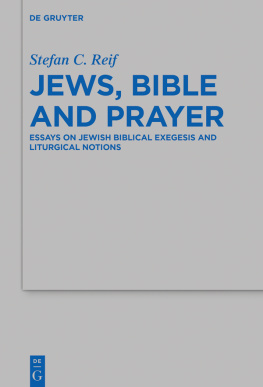Jewish Interpretation of the Bible
Ancient and Contemporary
Karin Hedner Zetterholm
Fortress Press
Minneapolis
Contents
JEWISH INTERPRETATION OF THE BIBLE
Ancient and Contemporary
Copyright 2012 Fortress Press. All rights reserved. Except for brief quotations in critical articles or reviews, no part of this book may be reproduced in any manner without prior written permission from the publisher. Visit http://www.augsburgfortress.org/copyrights/contact.asp or write to Permissions, Augsburg Fortress, Box 1209, Minneapolis, MN 55440.
Print ISBN: 978-0-8006-9798-3
eBook ISBN: 978-1-4514-2438-6
Library of Congress Cataloging-in-Publication Data
Zetterholm, Karin.
Jewish interpretation of the Bible : ancient and contemporary / Karin Hedner Zetterholm.
p. cm.
Includes bibliographical references (p. ) and indexes.
ISBN 978-0-8006-9798-3 (pbk. : alk. paper) ISBN 978-1-4514-2438-6 (ebook)
1. Bible. O.T.Criticism, interpretation, etc., Jewish. 2. Bible. N.T.Relation to the Old Testament. I. Title.
BS1186.Z48 2012
221.6088296dc23 2012011670
Cover image: Black Fire on White Fire, by Linda Berger Jacobs
Cover design: Laurie Ingram
Book design and typesetting: Josh Messner
The paper used in this publication meets the minimum requirements of American National Standard for Information SciencesPermanence of Paper for Printed Library Materials, ANSI Z329.48-1984.
Manufactured in the U.S.A.
16 15 14 13 12 1 2 3 4 5 6 7 8 9 10
This book was produced using PressBooks.com.
Agg. Ber. Aggadat Bereshit
A.J. Antiquitates judaicae (Josephus, Antiquities of the Jews)
b. Babylonian Talmud
B. J.Bellum judaicum (Josephus, Jewish Wars)
C. Ap.Contra Apionem (Josephus, Against Apion)
Cels. Contra Celsum (Origen)
Did. Didache (in Apostolic Fathers)
Eccl. Rab. Ecclesiastes Rabbah (in Midrash Rabbah)
Exod. Rab. Exodus Rabbah (in Midrash Rabbah)
Frg. Targ. Fragmentary Targum
Gen. Rab.Genesis Rabbah (in Midrash Rabbah)
Gos. Thom.Gospel of Thomas
Haer. Adversus Haereses (Irenaeus)
Hom. Matt. Homiliae in Matthaeum (John Chrysostom)
Jub.Jubilees (in Pseudepigrapha)
L.A.B.Liber antiquitatum biblicarum (Pseudo-Philo; in Pseudepigrapha)
Lam. Rab. Lamentations Rabbah
Leq. Tov Leqah Tov
Lev. Rab. Leviticus Rabbah (in Midrash Rabbah)
m.Mishnah
Macc. Maccabees (in Pseudepigrapha)
Mekh. R. Ishmael Mekhilta de-Rabbi Ishmael
Mekh. R. Shimon b. YohaiMekhilta de-Rabbi Shimon bar Yohai
Midr. ha-Gadol Midrash ha-Gadol
Midr. Psalms Midrash Psalms
Midr. Tannaim Midrash Tannaim
Num. Rab. Numbers Rabbah
Pirqe R. Eliezer Pirqe de-Rabbi Eliezer
Pes. Rabb. Pesiqta Rabbati
Pes. Rav Kah. Pesiqta de-Rav Kahana
S. Eliahu Zuta Seder Eliahu Zuta
S. Olam Rab. Seder Olam Rabbah
Songs Rab. Song of Songs Rabbah (in Midrash Rabbah)
t. Tosefta
Tanh. Midrash Tanhuma
Targ. Neof. Targum Neofiti
Targ. Onq. Targum Onqelos
Targ. Ps.-J. Targum Pseudo-Jonathan
y. Jerusalem/Palestinian (Yerushalmi) Talmud
Yalq. Shimoni Yalqut Shimoni
Tractates (Mishna, Tosefta, Talmud)
Avod. Zar. Avodah Zarah
B. Batra Bava Batra
B. Kama Bava Kama
B. Metzia Bava Metzia
Bek. Bekhorot
Ber. Berakhot
Eduy. Eduyyot
Eruv. Eruvin
Gitt. Gittin
Hag. Hagigah
Hor. Horayot
Ket. Ketubbot
Meg. Megillah
Menah. Menahot
Rosh Hash. Rosh Hashanah
Sanh. Sanhedrin
Shabb. Shabbat
Sot. Sotah
Tem. Temurah
Yad. Yadayim
Yebam. Yebamot
2
Preface and Acknowledgments
This book was originally written in Swedish with a general Swedish audience in mind, and to a large extent it has evolved around questions about Jewish tradition posed to me over the years by students and the public at large. These questions typically revolve around the ability of Jewish tradition to change and adapt while at the same time preserving a commitment to the Bible and its traditional interpretations. The combination of a seemingly free and at times even creative interpretation and reinterpretation of the Bible together with an insistence on the importance of and adherence to tradition within Judaism appears puzzling to many people whose background is in Protestant Christian tradition. How is it possible, for instance, to interpret away certain explicit biblical commandments but still insist on having separate dishes for meat and dairy products and to refrain from driving, writing, and knitting on the Sabbathcommandments and prohibitions that are not stated in the Bible?
This book addresses the ostensible paradox between commitment to the Bible and tradition on the one hand and the freedom in adapting them to present realities on the other. In order to comprehend this paradox, one needs to understand the underlying theology of revelation that, according to Jewish tradition, allows humans to be Gods partners in interpreting his word. This idea of an ongoing dialectical process between divine revelation and human interpretation is the key, I believe, to understanding the character and development of Jewish tradition.
The aim of the original book was to provide an accessible introduction to these issues for readers with little access to scholarly literature in English. While such introductions are more easily available to readers of English, it is my hope that the unique combination of the various areas covered in this book will lead to new insights. The treatment of the strategies that the rabbis of the rabbinic period developed in order to adapt Jewish tradition to new circumstances and the underlying views of revelation that allowed them to do it (chapter 1), together with the ways that the various denominations of contemporary Judaism address legislation of new issues and reconsider laws and customs that conflict with modern moral sensibilities, highlight the imprint that classical rabbinic Judaism has left on its modern forms. By placing the early Jesus movement within a Jewish hermeneutic tradition emphasizing its Jewish character (chapter 4), I hope to demonstrate the ways in which knowledge of Second Temple Judaism and Jewish hermeneutics may contribute to our understanding of the beginnings of Christianity. Chapters 2 and 3 present the major works that make up rabbinic literature and focus on the ways that the rabbis of the rabbinic period understood and interpreted the Bible and tradition. This part can be used as an introduction to rabbinic literature. A glossary of key terms is provided at the end of the book.









